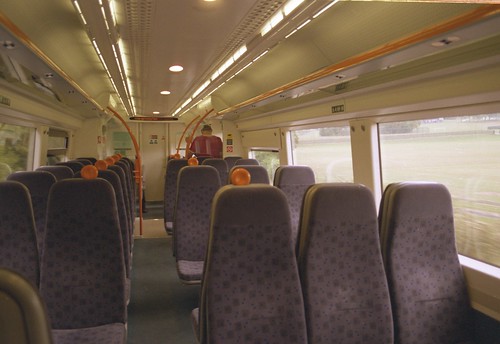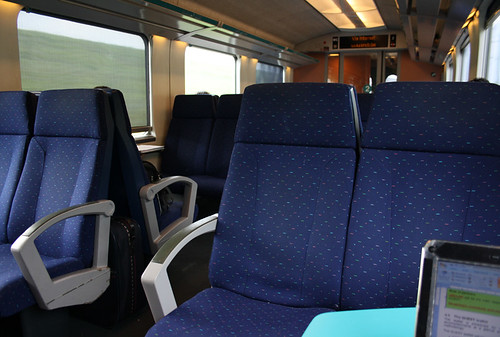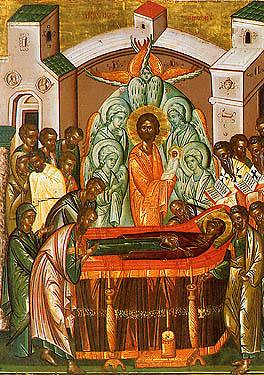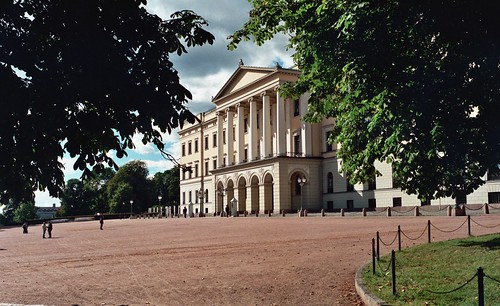The good news for Derby is that Bombardier has been awarded an order for 130 new Electrostar carriages for Southern. But what a pity that the opportunity was not taken to give these trains the design changes that would have made them so much better.
It is not that they are bad trains but there is plenty of room for improvement. It is unfortunate that design deficiencies are perpetuated over and over again instead of being dealt with through a programme of progressive development. This seems to be a British failing. We let ourselves down by not being sufficiently critical. Indeed, criticism is seen as disloyal and those who do it are regarded as whingers. It does not help the country's industrial performance.
torsdag 29 december 2011
måndag 26 december 2011
The religion of peace strikes again
At least 35 people were killed in an explosion in a Catholic church in the suburbs of Abuja in Nigeria, while a second explosion rocked a church in Jos.
Guardian article.
Guardian article.
fredag 23 december 2011
Mind the gap
At long last the hazard of station platform gaps has been brought to attention. There is an article on the subject here.
Some of the comments are amazingly complacent.
Some of the comments are amazingly complacent.
tisdag 20 december 2011
torsdag 8 december 2011
Advance train tickets cost more than you think
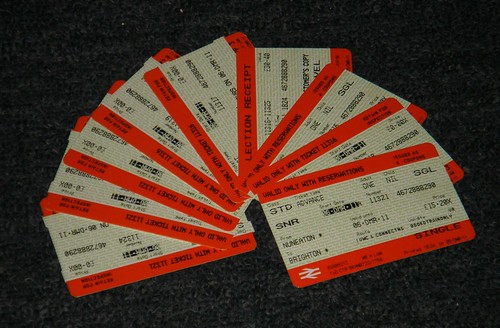
The hand of tickets I bought on Monday turned out to be money down the drain. Late on Monday evening I got a phone call from the people I was visiting to say their car had been run into and they could not see me because they would be spending the day trying to get it fixed and back on the road.
That is the trouble with advance tickets. Things can crop up to stop one making the journey. Which is why they are more expensive than they seem. People must realise this. So why do we have to put up with them?
Advance tickets are all about "Yield Management". Ideally, every train would have a full load of passengers for the whole length of its journey. Ideally, also, trains would run at regular intervals for 16 hours a day and every train would have the same number of carriages. But people prefer to travel when it suits them, and this gives rise to periods of peak demand. If the system is designed to carry peak traffic, then the trains will be more than half-empty for much of the time. Conversely, a system designed for off-peak traffic will be overcrowded at peak times.
Yield management is used to even out the traffic to match demand to supply. There is nothing new about the concept. From the earliest times, cheap excursion fares were offered, and at the weekends passengers travelled from the city to the seaside on commuter trains. On long-distance routes there were cheap mid-week tickets to tempt people to travel then rather than at the busy week-ends. At the busiest times of the year, seat reservations were compulsory for some trains. At the busiest times of the year, also, extra trains were run. If a particular train looked as if it was likely to be over-full, extra coaches could easily be added. Elderly trains were held in reserve for just this eventuality. At times, one was liable to travel in a train that belonged in a museum, but one could expect to get a seat, and sometimes a surprisingly comfortable though ancient one.
All this came to an end with the advent of fixed formation and multiple unit trains in the 1970s. These are so expensive that spare trains can not be held in reserve, and so complex, with so many cable connections between the vehicles, that extra carriages cannot easily be added. It can take several hours to remove a vehicle from some types of diesel multiple unit and and another half a day to put it back again and make sure everything is working properly.
Slower is faster
With the HS2 trains costing about twice as much as a conventional speed train, and the special trains for running on both HS2 and existing lines costing three times as much, the pressure on the operators to fill every seat at the maximum price will be even more acute. It is good economics but rotten service, and it adds to journey time because passengers have to turn up long before their train departs to be sure of not losing the journey they have paid for. From the passengers' point of view, a slower, regular interval walk-on service is faster!
In the long run, better technical solutions should be sought. The price of carriages needs to come down, and it should be made easier to add and remove vehicles, even if it means leaving off some of the frills we have become accustomed to such as computer points. Nevertheless, things could be improved. It is very expensive to keep all these booking systems up and running. It is not necessary to book every passenger into a particular seat on a particular train. The main need is to encourage people to travel off peak. It is not difficult to predict which trains are likely to be busy. Surely all that is needed is to have a relatively low standard fare and have all seats reservable on the busiest trains, with reservation fees set according to how popular the train was likely to be. And get rid of those bargain basement tickets which can turn out to be money down the drain.
måndag 5 december 2011
Hand of tickets
It took me the best part of half an hour to buy a ticket from Brighton to Nuneaton on the internet. Even then it was not what I wanted, as I would have preferred to go on the slower train and avoid changing at Rugby but that was more expensive, goodness knows why.
I was not able to print out my own ticket but had to go to the station and fetch it from a machine. This involved typing in a code on the touch screen keyboard, which is always awkward.
In the end, the machine spewed out ticket after ticket, and I finished up with these nine pieces of card. I will leave it to the ticket inspector to sort that lot out.
Why HS2 is such extraordinarily bad value for money
Supporters of HS2 have never addressed the point that the line costs about four or five times that of a conventional speed railway to build, the trains will cost twice that of conventional speed trains and the special trains for running on both HS2 and existing routes will cost half as much again.
Energy and other operating costs will be about double.
Put plainly: for the price of HS2 we could have about four times as much new railway. There are projects all over the country that are crying out to be done and which should take precedence. How about this for a little list for starters.
There would still be something left over and the benefits would start to appear long before 2026.
Energy and other operating costs will be about double.
Put plainly: for the price of HS2 we could have about four times as much new railway. There are projects all over the country that are crying out to be done and which should take precedence. How about this for a little list for starters.
- Reinstatement Oxford to Cambridge, Brighton to Guildford.
- Electrification Basingstoke to Salisbury and Reading, London to Birmingham via Banbury, Bristol to Birmingham, Cardiff to Swansea, Oxford to Birmingham, Crewe to Holyhead, Hastings to Ashford, Hurst Green to Uckfield, Newcastle to Carlisle as diversionary route.
- Complete doubling Oxford to Worcester, Swindon to Stroud, Salisbury to Exeter, Plymouth to Penzance, Tonbridge Wells to Hastings.
- Brighton main line - completion of 4-tracking of Three Bridges to Wivelsfield.
- Weaver Junction to Crewe - 4-tracking
There would still be something left over and the benefits would start to appear long before 2026.
What needs to be done, and why
Robin Smith explains all in a 30 minute interview from Occupy London. Brilliant.
lördag 3 december 2011
Virgins of the Islamic Paradise
I like to think of the Virgins of the Islamic Paradise turning out to be be nuns, preferably of the Sacred Heart Order, pre-Vatican 2.
Health and Safety
In a discussion in the Guardian's Comment is Free yesterday, I was asked, "Where in the Physiocrats' Laissez-Faire life of purity do you think health and safety legislation figures?"
It is an excellent question. Laissez-Faire concerns, primarily, the realm of economics. The answer to the question, however, lies in the common law concept of "duty of care". The fear and possibility of being sued is an excellent deterrent against laxity in matters of health and safety. Legislation should do no more than codify good practice for the guidance of the parties concerned.
In the economic sphere, the most important contribution of the Physiocrats is their proposal for the replacement of the multiplicity of contemporary taxes by the Single Tax, or Impôt Unique, which is explained in the Wikipedia if anyone is interested.
However, beware of the Wikipedia. Entries tend to be pulled this way and that by people pushing their own agendas (possibly including me, of course). Thus, "individualism" has been appropriated by Anarcho-Capitalists, who, when tackled, turn out to be bitterly opposed to the single tax proposal which they revile as communistic! The Physiocrat model is the antithesis of Anarcho-Capitalism.
The French Wikipedia entry on L'Impôt Unique is a good example of how unreliable it can be, since it describes it as the "Flat Tax", which it most definitely is not.
In present economic circumstances, the bargaining power of labour is weak, since most people have no option but to sell their labour power to an employer and are little more than wage slaves. The single tax policy would correct this imbalance so that employers and labour were bargaining from an equal position of strength. Employers who were careless about health and safety would quickly find that nobody would work for them.
It is an excellent question. Laissez-Faire concerns, primarily, the realm of economics. The answer to the question, however, lies in the common law concept of "duty of care". The fear and possibility of being sued is an excellent deterrent against laxity in matters of health and safety. Legislation should do no more than codify good practice for the guidance of the parties concerned.
In the economic sphere, the most important contribution of the Physiocrats is their proposal for the replacement of the multiplicity of contemporary taxes by the Single Tax, or Impôt Unique, which is explained in the Wikipedia if anyone is interested.
However, beware of the Wikipedia. Entries tend to be pulled this way and that by people pushing their own agendas (possibly including me, of course). Thus, "individualism" has been appropriated by Anarcho-Capitalists, who, when tackled, turn out to be bitterly opposed to the single tax proposal which they revile as communistic! The Physiocrat model is the antithesis of Anarcho-Capitalism.
The French Wikipedia entry on L'Impôt Unique is a good example of how unreliable it can be, since it describes it as the "Flat Tax", which it most definitely is not.
In present economic circumstances, the bargaining power of labour is weak, since most people have no option but to sell their labour power to an employer and are little more than wage slaves. The single tax policy would correct this imbalance so that employers and labour were bargaining from an equal position of strength. Employers who were careless about health and safety would quickly find that nobody would work for them.
onsdag 30 november 2011
Important projects get go-ahead
An initial reading of the Chancellor's Autumn statement reveals that the go-ahead has been given to the TransPennine electrification and the strategic Oxford-Bedford line.
These are two of dozens of projects around the country that cumulatively represent excellent value for money. We need a rolling programme of such schemes.
These are two of dozens of projects around the country that cumulatively represent excellent value for money. We need a rolling programme of such schemes.
måndag 28 november 2011
Lenovo X61 repair
I bought an X61 laptop recently, about four years old with nothing on the disk. These are very good value at around £150 on Ebay. With the small battery and without the docking bay it weighs about 1300 gm which makes it a powerful netbook, with a 1TB hard drive and 4GB RAM.
When started to use it I discovered minor damage to the plastic case. There was a split on the left hand side at the very rear, spreading from the corner of the fan ventilator. As a result the screen and lid were opening unevenly.
This is a stress point and a design flaw not on the earlier X31 I have. I would not be surprised if many X61 machines have exactly the same damage. I have mended it unobtrusively by cutting a piece of black plastic and super-gluing it over the crack, which reinforces where it is needed.
As it would have been easier to do this before the crack had occurred, it might be worth thinking about doing this preventatively.
fredag 25 november 2011
Who cares about tax havens?
There is more moaning about tax havens. Professional moaner about tax havens, Richard Murphy, has just published a book on the subject. I am sure it is a fascinating read. Personally I do not give a fig about about tax havens. They are the product of a rotten tax system.
If the bucket leaks it is up to the owner of the bucket to fix it. They should not blame the cat for lapping up the spilled milk.
If the bucket leaks it is up to the owner of the bucket to fix it. They should not blame the cat for lapping up the spilled milk.
tisdag 22 november 2011
Fanny may in the U-kay
The government's announcement of guarantees for 95% mortgages for house purchase, suppported by both Prime Minister Cameron and Deputy Clegg, demonstrates either an absolute lack of understanding of the nature of the problem, or moral cowardice, or both.
The aim, we are told, is to "unstick the housing market", which has stagnated due to the banks' refusal to give mortgages larger than 80% of the value of the property they are lending on.
Fanny May = taxpayers will pay
This sets the scene for a UK run of the Fannie Mae debacle. It will also pump up the housing bubble for a while. The government is doing the very thing it should not be doing.
If the housing market worked as advocates of the free market assure us it does, then the price of houses would drop to market-clearing levels. Some building firms would lose a lot of money, having bought land at the height of the boom and found themselves stuck with it in what they call their "land banks". That's market forces for you. They misjudged and overpaid. According to the principles of market capitalism, they would be allowed to fail for their mistake. But in the re-worked style of capitalism that is now being imposed in Britain, capitalists who get it wrong are handed out welfare at the expense of the taxpayers. It gives rise to moral hazard in a strangely reversed mirror-image style of socialism.
There are, apparently, about 300,000 housing units for which planning consent has been given but which have not been constructed. This is the "stickiness" referred to but the real cause is that the developers are asking too much and refuse to drop their prices to take account of the present state of the market. And so the taxpayers are being asked to pay for the developers' mistakes, and pay they will, because there will be defaults on some of these 95% mortgages
What should have happened was that the developers should have been made to pay the price. After all, they were happy to rake in the profits when land values were rising. Apart from having to provide a bit of social housing or planning gain, they enjoyed rich pickings from the increases in land value released by planning consents.
To get development moving again, all the government needed to do was to announce that as from 6 April 2013, sites with planning consent would be subject to the same Council Tax as if the development had been constructed. The sites would have been built on and the exchequer would have received useful extra revenue. It would not have been LVT but the end result would have been similar.
The aim, we are told, is to "unstick the housing market", which has stagnated due to the banks' refusal to give mortgages larger than 80% of the value of the property they are lending on.
Fanny May = taxpayers will pay
This sets the scene for a UK run of the Fannie Mae debacle. It will also pump up the housing bubble for a while. The government is doing the very thing it should not be doing.If the housing market worked as advocates of the free market assure us it does, then the price of houses would drop to market-clearing levels. Some building firms would lose a lot of money, having bought land at the height of the boom and found themselves stuck with it in what they call their "land banks". That's market forces for you. They misjudged and overpaid. According to the principles of market capitalism, they would be allowed to fail for their mistake. But in the re-worked style of capitalism that is now being imposed in Britain, capitalists who get it wrong are handed out welfare at the expense of the taxpayers. It gives rise to moral hazard in a strangely reversed mirror-image style of socialism.
There are, apparently, about 300,000 housing units for which planning consent has been given but which have not been constructed. This is the "stickiness" referred to but the real cause is that the developers are asking too much and refuse to drop their prices to take account of the present state of the market. And so the taxpayers are being asked to pay for the developers' mistakes, and pay they will, because there will be defaults on some of these 95% mortgages
What should have happened was that the developers should have been made to pay the price. After all, they were happy to rake in the profits when land values were rising. Apart from having to provide a bit of social housing or planning gain, they enjoyed rich pickings from the increases in land value released by planning consents.
To get development moving again, all the government needed to do was to announce that as from 6 April 2013, sites with planning consent would be subject to the same Council Tax as if the development had been constructed. The sites would have been built on and the exchequer would have received useful extra revenue. It would not have been LVT but the end result would have been similar.
söndag 20 november 2011
Traditional Latin Mass is the future
From next week, for a trial period, our local parish priest has decided to say an Traditional Latin Mass (TLM) every Sunday. This is partly a response to the growing attendance at the weekly Friday evening TLM, and partly as a result of experience with using this liturgy on other occasions. The surprise has been that it is more accessible and inclusive than the 1970 Mass in any of its forms. This is not an experience confined to the local parish, as I have noticed it elsewhere. The future of the Catholic church is with the TLM, accompanied of course by other practices such as regular prayer by the laity and regular confession.
The main benefits are, first and foremost, that it is perceived as more prayerful. There are extended and well-defined periods of silence, but it is a silence in which something is happening. With the priest facing in the same direction as the rest of the congregation, there is a stronger sense that everyone is taking part in the action, which is less dominated by the celebrant. The priest finds it less distracting. The sacred mysteries are shielded from the full view of the congregation just as they are in an Orthodox liturgy where the altar is situated behind the iconostasis. The servers have an easier task as everything is carefully prescribed and it is necessary only to learn what has to be done and when.
The use of Latin is inclusive. Language is a great divider, separating both nations and social groups within nations. Latin cuts across all these divisions, since it has long since ceased to be the property of any particular nation. The TLM also has the advantage that the choir is singing during the long recitation of the prayers of consecration, which are best followed silently in the missal in whatever language one chooses.
Paradoxically, this growing realisation of the quality and accessibility of the TLM comes at an unfortunate time, because the new, and much improved English translation of the 1970 (Novus Ordo, NO) Mass has just been brought into use. One wonders now what its long-term future is? Its main value may in the end be for catechesis.
A further question raised is this. What is the legality of introducing TLM practices into an NO celebration? What if all the NO rubrics were followed but the prayers were to be said in English? What if the prayers at the foot of the altar and the Last Gospel were recited? What if the Canon of the Mass was said silently, either in Latin or the vernacular? These things are not provided for in the General Instruction of the Roman Missal (GIRM), which stipulates how thing should be done, but on the other hand, celebration of the NO mass is still very much according to the way the particular priest chooses to do it. Would it then be wrong for a priest to adopt TLM prayers and rubrics in an NO Mass?
The main benefits are, first and foremost, that it is perceived as more prayerful. There are extended and well-defined periods of silence, but it is a silence in which something is happening. With the priest facing in the same direction as the rest of the congregation, there is a stronger sense that everyone is taking part in the action, which is less dominated by the celebrant. The priest finds it less distracting. The sacred mysteries are shielded from the full view of the congregation just as they are in an Orthodox liturgy where the altar is situated behind the iconostasis. The servers have an easier task as everything is carefully prescribed and it is necessary only to learn what has to be done and when.
The use of Latin is inclusive. Language is a great divider, separating both nations and social groups within nations. Latin cuts across all these divisions, since it has long since ceased to be the property of any particular nation. The TLM also has the advantage that the choir is singing during the long recitation of the prayers of consecration, which are best followed silently in the missal in whatever language one chooses.
Paradoxically, this growing realisation of the quality and accessibility of the TLM comes at an unfortunate time, because the new, and much improved English translation of the 1970 (Novus Ordo, NO) Mass has just been brought into use. One wonders now what its long-term future is? Its main value may in the end be for catechesis.
A further question raised is this. What is the legality of introducing TLM practices into an NO celebration? What if all the NO rubrics were followed but the prayers were to be said in English? What if the prayers at the foot of the altar and the Last Gospel were recited? What if the Canon of the Mass was said silently, either in Latin or the vernacular? These things are not provided for in the General Instruction of the Roman Missal (GIRM), which stipulates how thing should be done, but on the other hand, celebration of the NO mass is still very much according to the way the particular priest chooses to do it. Would it then be wrong for a priest to adopt TLM prayers and rubrics in an NO Mass?
fredag 18 november 2011
Trains too long
Chiltern Railways has extended a service to London by an extra carriage; great for easing overcrowding, but less helpful to the commuters stuck at Saunderton station because their platform is too short.
Is it beyond the ingenuity of the industry's engineers to devise a system with a detector and locking system so that a door can be opened only if there is a station platform alongside?
Article here
Is it beyond the ingenuity of the industry's engineers to devise a system with a detector and locking system so that a door can be opened only if there is a station platform alongside?
Article here
onsdag 16 november 2011
The lost route into London
Before the electrification of the West Coast Main Line, there were two routes from London to Birmingham, with little to choose between them. The direct Great Western route, which ran through High Wycombe and Bicester, was then more or less abandoned as a through service, with the section from High Wycombe to Aynho Junction being reduced to single track.
Since privatisation, the route has been upgraded and converted back to double track. Earlier this year Chiltern Railways introduced a through service from Marylebone to Birmingham, and there is even a suggestion to electrify the route.
Unfortunately, further development is going to be limited by restrictions at Marylebone, which in the space of twenty years has been transformed from a sleepy backwater to a very busy station with a large volume of local traffic.
There is, however, another route into London which is scarcely used - the former main line into Paddington which branches off the Great Western route to the west at Old Oak Common and then run alongside the Central Line to Ruislip; the line from Marylebone joins this line at Northolt Junction.
At present it would not be possible to increase the amount of traffic on this route due to the volume of traffic using Paddington. If, on the other hand, the Heathrow Express were removed and given an underground terminus of its own, as part of the Crossrail project, this would reinstate the entire route and double the capacity between London and Birmingham.
Since privatisation, the route has been upgraded and converted back to double track. Earlier this year Chiltern Railways introduced a through service from Marylebone to Birmingham, and there is even a suggestion to electrify the route.
Unfortunately, further development is going to be limited by restrictions at Marylebone, which in the space of twenty years has been transformed from a sleepy backwater to a very busy station with a large volume of local traffic.
There is, however, another route into London which is scarcely used - the former main line into Paddington which branches off the Great Western route to the west at Old Oak Common and then run alongside the Central Line to Ruislip; the line from Marylebone joins this line at Northolt Junction.
At present it would not be possible to increase the amount of traffic on this route due to the volume of traffic using Paddington. If, on the other hand, the Heathrow Express were removed and given an underground terminus of its own, as part of the Crossrail project, this would reinstate the entire route and double the capacity between London and Birmingham.
måndag 14 november 2011
More Electrostars coming to Southern?
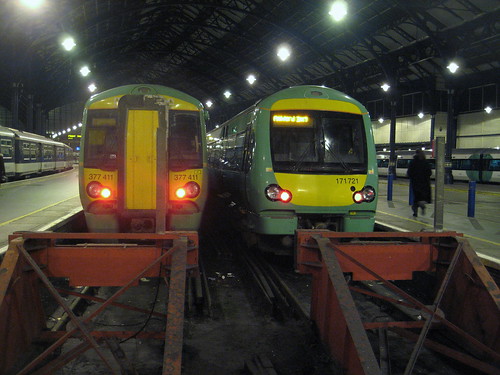


Electrostars, the EMU originally developed by AdTranz before it was taken over by Bombardier, are a mixed bunch. The first entered service around 2000 and comprise classes 357, 375, 376, 377, 378 and 379. Originally they were quite unreliable but they are now in the same league as the EPB units which they replaced, dating from the 1960s.
Variations include alternative seating layouts, sliding or plug doors, full width cabs or half-cabs with gangways (top picture), and AC, DC or dual voltage types.
Probably the most successful version is the class 378 for London Overground (second picture), which has sliding doors and longitudinal seating, an ideal layout for the type of service for which they are used.
Some versions are very comfortable, for example the end cars in the units operating on the Southern main lines (third picture) have 2+2 seating with tables, all aligned to the windows.
Much less satisfactory are the vehicles with 2+3 seating. The bodyshells are not wide enough for 2+3 seating, due to the way the bodysides are curved below the window, with the space being further cut into by ducts at skirting level. This reduces the width at floor level, so that passengers sitting by the window cannot put both feet on the ground straight in front of them, and the gangway is so narrow that special catering trolleys had to be obtained.
The reason for this curvature is not clear because the steps project beyond it, and platform levels are always well below the level of the bottom of the bodyside. It appears to be nothing more than a styling feature, and whilst it looks quite elegant, style should not be at the expense of space and comfort.
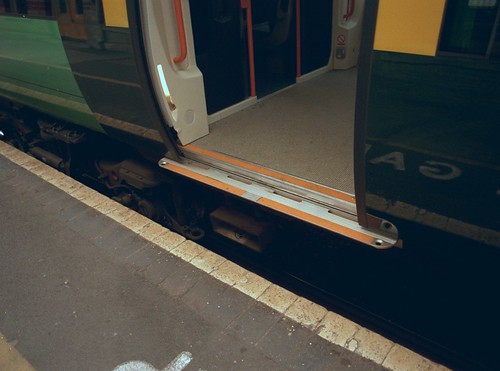
Another fault is that at concave platforms there is a large gap between the platform and the train. This is due to the position of the doors. The closer the doors are to the bogie centres, the less the gap at curved platforms. Trains such as the end-door class 158 are particularly good from this point of view.
The argument for locating the doors more centrally is that it improves station dwell times, but getting on and off Electrostars at some platforms at stations like Clapham Junction can be a bit of an adventure as there is a chasm to be negotiated. This cannot be good for station dwell time. There is a need for more research on this topic.
One way and another, the Electrostars would benefit from design changes to address these issues before further examples are built.
Paedophile clerics - who should pay?
The recent decision by the courts, that priests are in effect employees and answerable to their bishops, raises two concerns. These will presumably be considered by the appeal court to whom the matter has now been referred.
First, there is the substance of the complaints themselves. Many of these relate to incidents long ago. The principal actors are in many cases long dead and cannot be cross-examined. There is a lot of money at stake. How can genuine victims be distinguished from gold-diggers?
Second, in the event of damages being awarded, who should be responsible for paying?
Parishioners contribute to the church's funds, and it appears that these are held by trustees under rules set by the Charity Commissioners. Is compensation for actions due to a bishop's negligence a proper use of these funds?
There would be a good case to argue that they are not. Most people would not give money to the church if they thought it was going to be used for such a purpose. In effect, it would be to underwrite the actions of the bishop, over whose appointment and actions they had no control. Dissatisfaction with bishops is widespread, with concerns about matters that extend well beyond the misbehaviour of what is still, fortunately, a tiny minority of priests.
In a hierarchical body such as the church, the chain of accountability is upwards, so that responsibility for the actions of a bishops must surely lie with whoever appointed him. Or could the liability be personal?
First, there is the substance of the complaints themselves. Many of these relate to incidents long ago. The principal actors are in many cases long dead and cannot be cross-examined. There is a lot of money at stake. How can genuine victims be distinguished from gold-diggers?
Second, in the event of damages being awarded, who should be responsible for paying?
Parishioners contribute to the church's funds, and it appears that these are held by trustees under rules set by the Charity Commissioners. Is compensation for actions due to a bishop's negligence a proper use of these funds?
There would be a good case to argue that they are not. Most people would not give money to the church if they thought it was going to be used for such a purpose. In effect, it would be to underwrite the actions of the bishop, over whose appointment and actions they had no control. Dissatisfaction with bishops is widespread, with concerns about matters that extend well beyond the misbehaviour of what is still, fortunately, a tiny minority of priests.
In a hierarchical body such as the church, the chain of accountability is upwards, so that responsibility for the actions of a bishops must surely lie with whoever appointed him. Or could the liability be personal?
onsdag 9 november 2011
Limits of democracy

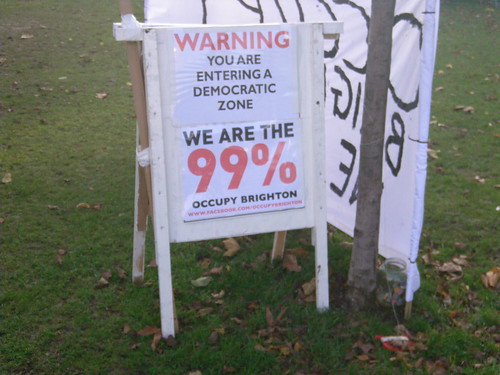
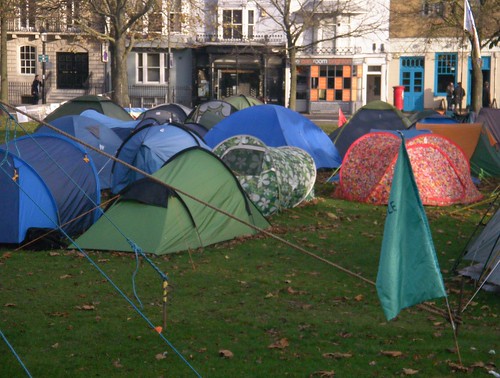
This is the protest camp that has sprung up in Brighton, in Victoria Gardens. It seems to be dominated by the local anarchists. I have a certain sympathy with their anger as they are the generation that is paying for the decades of mismanagement of the economy.
However, a brazier was burning under a large and very old tree, which cannot have been good for it. I suggested that they might like to move it to where there were no tree branches above. I mentioned this to someone there, and she said she accepted the point and would put it to everyone at the meeting. It seems as if there is a democratic structure in which everyone has an equal voice. Perfect democracy, one might say.
Except this. It is worrying that nobody had the sense to realise that fires should not be lit under trees. But in situations like this, there are those who know and those who do not, and giving everyone an equal voice could have a bad outcome. It is like trying to run a ship with a committee made up of the entire crew, and giving them an equal say, when there are some who know about sails or engines, some about cooking, some about navigation, some about radio, some who are normally content to shift heavy stuff around, and so on. You cannot leave technical decisions in the hands of people who are not versed in the relevant discipline.
The Brighton occupation raises another point. Most of the campers seem to be middle class, affecting a working class accent. They have the resources to equip themselves with comfortable, weathertight accommodation. But also in Brighton is a hard core of genuinely homeless people, with nowhere to go, who are living in the streets and sleeping in shop doorways.
I wonder if it has occurred to these concerned anarchists to engage with their neighbours who have fallen through all the safety nets? How would they feel about sharing their well-found accommodation with those much worse-off than themselves?
The single tax is not a tax
Transport Select Committee ifs and buts
In its report published yesterday, the Select Committee has succeeded in drawing opposite conclusions simultaneously. The headline can be taken as a go-ahead signal - but the qualifications are so many and so significant (see preceding post) that it must be read as a recommendation to stop and reconsider the project.
It seems to me that the real question that still needs to be asked is whether, given a decision to spend this amount on transport, high speed rail is the best investment.
To get at the cost of an alternative, a comparison is the reconstruction of the line between Edinburgh and Tweedbank, a 49km stretch, at a cost of around £250 million - £5 million per km. The cost of the 200km HS2 line between London and Birmingham is given as £16 billion - £80 million per km. However, HS2 includes some very expensive tunneling at the London end which would have to be constructed regardless if capacity is to be increased, whilst the Edinburgh to Tweedbank route will not of course, be electrified, and is partially single track. Taking account of these differences, a reasonable estimate for reinstating an existing alignment as a good quality main line would be around £10 million per km for a double track route, plus another £2 million for electrification - a total of around £12 million.
Thus, the same amount of money will buy many times more conventional railway - and there are worthwhile schemes all over the country waiting to be built, mostly involving reinstatement of Beeching closures in areas where the population has greatly increased, reinstatement of double-track routes which have been singled, works to remove bottlenecks and speed restrictions, and electrification. The route of HS2 itself could be one such reinstatement, and would provide the same capacity enhancement. The existing GC main line alignment, whilst suitable as a conventional railway, cannot, however, be made into a high speed line.
The poor value for money also applies to rolling stock. A standard high speed train costs £30 million - that is the price of two conventional trains with the same capacity, or six 4-car Electrostars. But the aim is that some trains would be able to run onto the existing rail network. These would need to be specially designed and cost around £52 million each. This extra cost reflects both the non-standard design and the premium for a one-off order.
It is considerations such as these that the government must now take into account before proceeding further.
It seems to me that the real question that still needs to be asked is whether, given a decision to spend this amount on transport, high speed rail is the best investment.
To get at the cost of an alternative, a comparison is the reconstruction of the line between Edinburgh and Tweedbank, a 49km stretch, at a cost of around £250 million - £5 million per km. The cost of the 200km HS2 line between London and Birmingham is given as £16 billion - £80 million per km. However, HS2 includes some very expensive tunneling at the London end which would have to be constructed regardless if capacity is to be increased, whilst the Edinburgh to Tweedbank route will not of course, be electrified, and is partially single track. Taking account of these differences, a reasonable estimate for reinstating an existing alignment as a good quality main line would be around £10 million per km for a double track route, plus another £2 million for electrification - a total of around £12 million.
Thus, the same amount of money will buy many times more conventional railway - and there are worthwhile schemes all over the country waiting to be built, mostly involving reinstatement of Beeching closures in areas where the population has greatly increased, reinstatement of double-track routes which have been singled, works to remove bottlenecks and speed restrictions, and electrification. The route of HS2 itself could be one such reinstatement, and would provide the same capacity enhancement. The existing GC main line alignment, whilst suitable as a conventional railway, cannot, however, be made into a high speed line.
The poor value for money also applies to rolling stock. A standard high speed train costs £30 million - that is the price of two conventional trains with the same capacity, or six 4-car Electrostars. But the aim is that some trains would be able to run onto the existing rail network. These would need to be specially designed and cost around £52 million each. This extra cost reflects both the non-standard design and the premium for a one-off order.
It is considerations such as these that the government must now take into account before proceeding further.
tisdag 8 november 2011
Transport Select Committee publishes HS2 report
There is a good case for a high speed rail network, linking London and the major cities of the Midlands, the North and Scotland says the Commons Transport Committee.
The Transport Committee sets out a series of recommendations on high speed rail:
Launching High Speed Rail – the report of the inquiry into high speed rail, including the Government’s proposal for HS2 – committee chair Louise Ellman said,
"A high speed rail network, beginning with a line between London and the West Midlands, would provide a step change in the capacity, quality, reliability and frequency of rail services between our major cities.
A high speed line offers potential economic and strategic benefits which a conventional line does not, including a dramatic improvement in connectivity between our major cities, Heathrow and other airports, and the rest of Europe.
High speed rail may be a catalyst for economic growth, helping to rebalance the economy and bridge the north-south divide. But the Government must do more to promote local and regional growth strategies to ensure we get maximum economic benefit from high speed rail.
High speed rail is affordable: HS2 will cost around £2 billion per annum over 17 years. Construction of a high speed rail network should start with the line between London and the West Midlands, as this is where capacity needs are greatest. But we are concerned that under current plans high speed rail lines won’t reach Manchester and Leeds for more than 20 years.
The Government should also look at options to build southwards from the north and link to other lines such as the Midland Main Line. We see no reason why the Scottish Government should not begin work on a Scottish high speed line, to connect with the English network in due course.
Investment in HS2 must not lead to reduced investment in the 'classic' rail network. We are concerned that the Government is developing separate strategies for rail and aviation, with HS2 separate from both. We call again for the publication of a comprehensive transport strategy.
Investment in high speed rail has potential to boost growth but may have a substantial negative impact on the countryside, communities and people along the route. This must be better reflected in the business case for HS2 and future phases of the project. We would encourage the Government to follow existing transport corridors wherever possible."Recommendations
The Transport Committee sets out a series of recommendations on high speed rail:
- The Government must firmly commit to the Y network before seeking parliamentary approval for HS2
- If the Government decides to go ahead with HS2, it should publish a summary of the financial case showing how the project is affordable alongside sustained investment in the classic network as well as its priorities for expenditure in the next Network Rail control period (for 2014-19)
- More information about the Y network (to Leeds and Manchester) such as the location of stations and environmental impacts should be published and strategically appraised before a final decision on HS2 is made
- A full assessment of the case for building from north to south should be carried out as a priority
- It is disappointing that a major strategic scheme is being designed and assessed to a large extent based upon the value of travel time savings, which are not universally accepted. This issue should be addressed in the updated economic case for HS2 with the implications for scheme design made explicit
- The Government needs to make clear how HS2 fits into its wider aviation strategy, looking again at the case for a direct link to Heathrow in phase I on the assumption that the high speed rail network will extend to Manchester and Leeds. The costs and benefits of routing HS2 via Heathrow should be set out more clearly and there should be a clear statement about the status of possible complementary schemes such as those which would link Heathrow by rail to Gatwick or the Great Western Main Line
- Better information should be provided to explain the Government's rationale for its proposals for London termini and linkages, which are the most expensive and complex elements of HS2
- Operating 18 trains per hour at 225mph are risk factors for which more technical information should be published. It is questionable whether the system proposed is being designed with sufficient margin for expansion
- Claims that HS2 would deliver substantial carbon-reduction benefits do not stand up to scrutiny. However, HS2 will produce less carbon than an expanded motorway network or greater domestic aviation in the event of increased demand for inter-urban travel
- Government support to enable the full potential of high speed rail to be realised, - including funding, for the development of regional and local strategies for transport, housing, skills and employment - should be recognised as a priority
- When announcing its decision on HS2, the Government should provide a more explicit and comprehensive statement about likely patterns of service on the classic network once HS2 is operational
- The Government should engage with Network Rail to identify whether there are affordable options to enable more peak-time capacity to be provided for Milton Keynes and Northampton commuters before HS2 opens
- The Government should desist from disparaging opponents of high speed rail as NIMBYs. Both sides in the debate should show respect for each other and focus on the facts
måndag 7 november 2011
Latin Mass goes from strength to strength
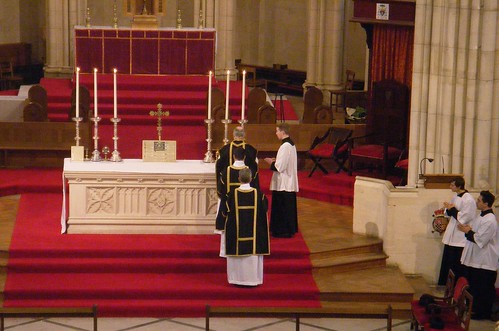
Traditional Latin Mass- Arundel Cathedral, a photo by Henry░Law on Flickr.
This would have been a rare sight even ten years ago, but with the publication of Summorum Pontificum in 2007, and the removal of the remaining restrictions on its use, the old rite (Tridentine) Mass is being celebrated quite frequently, at least in some places.
When the restrictions were lifted, people seem to have thought that it would be an exception, and hence it was styled the "Extraordinary Form" (EF), as against the Novus Ordo (NO) liturgy now termed the "Ordinary Form". What was perhaps not expected was that it is, though very slowly, becoming mainstream. A couple of parishes have adopted it as the main Sunday sung mass, whilst there is a growing number of Sunday celebrations once a month, and regular Low Masses on weekdays. Also surprising (or perhaps not so surprising), is that attendance is no longer exclusively by the ageing stalwarts who have supported the Latin Mass Society for the last forty years. A substantial contingent of under-30s is now typical in congregations at these liturgies.
Equally surprising is that an increasing number of parishioners with no special interest in the liturgy are comfortable with the EF Mass, and possibly more so now that the new English translation has come into use. This latter is a great improvement on the old translation and has prompted attempts at setting the new texts to the traditional Gregorian Chants. These are of mixed quality. The rhythms of the English language do not suit the Gregorian Chant, which is presumably why Anglican Chant was devised. An increasing use of Latin is also leading to liturgies which switch awkwardly and unpredictably between the two languages. The logical conclusion of this trend is to do everything in Latin apart from the readings, but in the NO, there is the long period when the Canon of the Mass is recited, which does not work particularly well in Latin, but which in the EF form is said silently whilst the choir is singing the Sanctus.
This difference, which is the most noticeable one to anyone in the congregation, means, perhaps surprisingly, that the EF Mass is more accessible than the newer form. A further benefit is that where parishes are ethnically mixed, not only is the Latin neutral ground, it would also help to unify parishes which have become divided into different national groups according to which mass they attend.
The sooner that parish priests realise this, the better.
fredag 4 november 2011
Catholic architecture
The design of the London Oratory, seen here on the Feast of Corpus Christi, is what became standard after the Council of Trent. It is clear and logical both from an architectural and theological point of view. There is a linear progression from secular to sacred: nave, then sanctuary, marked by a change in level and altar rails, then further steps leading to the altar, then reredos with the tabernacle in a raised position in the centre, the whole surmounted by, and culminating in, the crucifix and three flanking candles on either side.
The sacredness of the sanctuary is further emphasised by a change in flooring materials and rules concerning who is permitted to be there and what clothing they should wear.
It would be difficult to think of an architectural form that could more clearly express Catholic theology. This architectural and ceremonial use of differences to present teachings of a profound nature, is, as Claude Lévi-Strauss explored in his development of structural anthropology, a common thread in all human societies. Neglect it at our peril.
The sacredness of the sanctuary is further emphasised by a change in flooring materials and rules concerning who is permitted to be there and what clothing they should wear.
It would be difficult to think of an architectural form that could more clearly express Catholic theology. This architectural and ceremonial use of differences to present teachings of a profound nature, is, as Claude Lévi-Strauss explored in his development of structural anthropology, a common thread in all human societies. Neglect it at our peril.
torsdag 3 november 2011
More web fraud - take care
I have been receiving emails purporting to come from Paypal and asking for confirmation of my username and password. It seems as if they are being intercepted.
This was an obvious fraud but I clicked on the link and was directed to a login page which looked like the official one. But the web address did not begin with https. I entered my email address and a made-up password which logged me in to some site with a form asking for various details, again without the https prefix.
If you get one of these, report the fraud to whoever is being imitated. Yahoo, Google, Paypal and the banks have their own email address for this.
This was an obvious fraud but I clicked on the link and was directed to a login page which looked like the official one. But the web address did not begin with https. I entered my email address and a made-up password which logged me in to some site with a form asking for various details, again without the https prefix.
If you get one of these, report the fraud to whoever is being imitated. Yahoo, Google, Paypal and the banks have their own email address for this.
måndag 31 oktober 2011
Stop messing about with the clocks
Yet again we have to change the clocks. There seem to be more than ever, with clocks on things that never used to have clocks but which do not change themselves automatically.
Some people are suggesting that the UK should stay on Summer Time all the year round. The last time this was tried was around 1968 and it was unpopular in Scotland, where it did not begin to get light in Glasgow in January until about 9.30 in the morning.
Our continental neighbours are on Central European Time which is an hour later than Greenwich Mean Time. That suits their situation perfectly well. But nobody can do anything about the fact that noon is more than an hour later in Glasgow than it is in Berlin and Stockholm, nor that in higher latitudes the days are shorter in the winter.
Clocks are set up so that noon - when the sun is at its highest, is at 12.00. Putting the clocks forward by an hour in the summer is just a way of making people get up an hour earlier. The same result could be achieved by changing work and school starting times from around Easter till the end of October.
Time to stop messing about with the clocks.
Some people are suggesting that the UK should stay on Summer Time all the year round. The last time this was tried was around 1968 and it was unpopular in Scotland, where it did not begin to get light in Glasgow in January until about 9.30 in the morning.
Our continental neighbours are on Central European Time which is an hour later than Greenwich Mean Time. That suits their situation perfectly well. But nobody can do anything about the fact that noon is more than an hour later in Glasgow than it is in Berlin and Stockholm, nor that in higher latitudes the days are shorter in the winter.
Clocks are set up so that noon - when the sun is at its highest, is at 12.00. Putting the clocks forward by an hour in the summer is just a way of making people get up an hour earlier. The same result could be achieved by changing work and school starting times from around Easter till the end of October.
Time to stop messing about with the clocks.
fredag 21 oktober 2011
Energy efficiency in the home
I have just received an energy efficiency appraisal for my house, which is required before I can sell it. It contains advice on steps that could be taking to make it more efficient. These included
One measure not suggested in the report was the use of a dehumidifier. In damp weather it can feel uncomfortably chilly even though the outside temperature is 15 degrees or more. It is then necessary to heat the building to around 25 degrees. By removing the moisture, the environment is comfortable at a lower temperature. A dehumidifier is also an efficient substitute for a tumbler drier, extracting the latent heat from the evaporating moisture and distributing it around the house as warm, dry air.
- Fit low energy bulbs at a cost of £15 to save £23 a year
- Upgrade heating controls at a cost of £350 - £450 to save £38 a year
- Replace boiler with new condensing boiler at a cost of £1,500 - £3,500 to save £46 a year
- Solar water heating £4,000 - £6,000 to save £33 a year
- Replace single glazed windows with double glazed at a cost of £2,500 - £6,500 to save £70 a year
- Fit photovoltaic panels at a cost of £11,000 - £20,000 to save £222 a year
From which it can be concluded that the most effective energy-saving measure I could make would be to put on an extra layer of clothes.
One measure not suggested in the report was the use of a dehumidifier. In damp weather it can feel uncomfortably chilly even though the outside temperature is 15 degrees or more. It is then necessary to heat the building to around 25 degrees. By removing the moisture, the environment is comfortable at a lower temperature. A dehumidifier is also an efficient substitute for a tumbler drier, extracting the latent heat from the evaporating moisture and distributing it around the house as warm, dry air.
söndag 16 oktober 2011
Novus Ordo versus Usus Antiquor
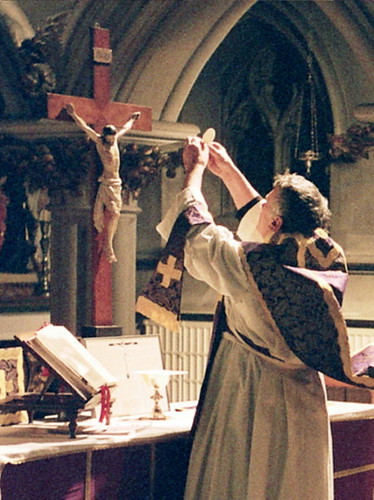
On Saturday, the Association for Latin Liturgy had an event at St Mary Magdalen's in Brighton, including the celebration of a Solemn High Mass according to the Novus Ordo rite, all in Latin, with the priest in the ad orientem position and sung Gregorian Chant throughout, apart from the readings which were in English.
This is as good as the Novus Ordo Mass can get, but it raises questions. Ever since Pope Benedict announced that the Tridentine form had never been abrogated and that no special permission was required for its celebration, an increasing number of parish priests, though still a small minority, have been using this rite, now known as the Extraordinary Form. At St Mary Magdalen's we have it every Friday evening, and once a month on a Sunday afternoon. These liturgies have attracted a regular following, with a good proportion of young people, and now that we are used to it, comparison with the Novus Ordo Mass in Latin is instructive.
From the perspective of someone in the congregation, the first impression is that there is very little difference between the two. The second impression is the amount of time taken for the recitation of the Canon of the Mass in Latin in the newer rite, which would be silent in the older rite, with the singing of the Sanctus taking place at the same time. The effect in the new mass is to prolong it unduly and to no apparent gain. For a lay person not familiar with Latin ie nearly everyone, the Tridentine Mass is actually more accessible. Which makes me wonder if the Novus Ordo has any future in the longer term.
torsdag 29 september 2011
New Electrostar order in the offing?

Reports are that a further build of Bombardier Electrostars could be ordered by Southern, for use on the Brighton main line. This would be good news for Derby.
It is possible to have a comfortable ride on the Southern Electrostars, but really they are an inner suburban design and the best implementation of the type is the class 378 for London Overground. For longer-distance services, they would be better with modifications to the original design, which has its origin in the British Rail Networker, an inner suburban design developed in the 1980s.
The most beneficial change would be to move the doorways to the ends. This would have four advantages.
- The gap between platform and train would be constant, regardless of the curvature of the track. This would avoid the large gaps that passengers have to negotiate at stations with sharply curved concave platform faces and consequently reduce station dwell times.
- With a single saloon 14.4 metres long, there would be more flexibility in arranging alternative seating layouts.
- Internal doors at the entrance to saloons would be possible, thereby reducing the load on the heating and ventilation system when the train doors were open.
- End doors give better structural integrity than can be achieved when it is necessary to provide large openings in the bodyshell one-third of the way from each end. This might lead to a reduction in weight.
The third modification would be to raise the floor level to the former standard of 1.300 mm above track level. This would provide additional width at floor level and allow space for a proper step instead of the present awkward and hazardous half-step.
The fourth modification, would be the fitting of proper retractable steps such as this one from Knorr-Bremse, as well as wheelchair access ramps.

Again, in addition to safety benefits, this would cut station dwell times especially at busy stations with curved platforms such as East Croydon and Clapham Junction.
söndag 25 september 2011
Regional services
I just arrived in Brighton after a journey from Oxford that took four hours. The outward journey took 2 hours 25 minutes due to catching an earlier train than the advertised connection at Reading. In both directions the journey was uncomfortable, with the trains very overcrowed on the return.
These are the kind of journeys where most people's would automatically opt to go by car, and no wonder.
söndag 11 september 2011
East West Rail can help economic development
The proposed East-West Rail Link connecting Oxford and Aylesbury with Milton Keynes and Bedford could generate more than £38 million a year for the UK economy, says a leading economic forecaster.
Oxford Economics, which has just published a report on the economic case for investment, says there is a strong business case for reinstating track and upgrading the line to enable an East-West rail service to carry passengers from Reading to Bedford via Oxford and Milton Keynes and from Milton Keynes into London Marylebone via Aylesbury and High Wycombe.
The report – East West Rail: The Economic Case for Investment – comes at a time when there are concerns about the low economic growth outlook for the UK, and has been welcomed by a Consortium of councils and Local Enterprise Partnerships supporting an east-west rail link.
Oxford Economics, which has just published a report on the economic case for investment, says there is a strong business case for reinstating track and upgrading the line to enable an East-West rail service to carry passengers from Reading to Bedford via Oxford and Milton Keynes and from Milton Keynes into London Marylebone via Aylesbury and High Wycombe.
The report – East West Rail: The Economic Case for Investment – comes at a time when there are concerns about the low economic growth outlook for the UK, and has been welcomed by a Consortium of councils and Local Enterprise Partnerships supporting an east-west rail link.
The case for this is so blatantly obvious that it is astonishing that the government is not driving it forward with the utmost urgency. In any other country in Europe with similar traffic densities, the entire group of routes from Marylebone to Birmingham, Paddington to Oxford and Banbury, and the east-west link would be in a rolling programme for upgrading and electrification.
onsdag 7 september 2011
Did the holocaust really happen?
This blog assembles a mass of evidence as concisely as it is possible (article is in Swedish but the pictures are bad enough)
tisdag 6 september 2011
Linhof Technika Camera for sale
A magnificent piece of German craftsmanship dating from the late 1950s, I have had this camera since 1977 but hardly used it as the project I bought it for never happened. The camera has a ground glass back and a roll film carrier to take 10 exposures on 120 roll film ie 6 x 7 cm. It has a coupled rangefinder and three matching Schneider lenses, a 65 mm f/8 Super Angulon, a 105 mm f/3.5 Xenar and a 150 mm f/5.6 Apo Symmar. All the lenses are Linhof selected. The original owner seems hardly to have used it either so it is in excellent condition, including the bellows.
It will be available for purchase on Ebay in about two weeks time.
High speed to nowhere
Three critical pieces on high speed rail from the Economist
Railroad to nowhereMeanwhile, Rail magazine continues to enthuse about the HS2 project, even though the latest issue contains a piece extolling the benefits of the East-West route, a modestly priced scheme which is still far from being given the go-ahead.
måndag 5 september 2011
Inter City Express - not wanted and not needed
A firm order for the Hitachi Inter City Express (IEP) has still not been placed. The trains will, if ordered, run initially on Great Western routes out of Paddington, which on current plans will be electrified to Bristol, probably to Swansea, and to Oxford and Newbury. This will still leave a substantial mileage without electrification, including most of the main route from London to Cornwall, the line to Worcester and Hereford, and the West Wales area. In theory, a train like the IEP, which can run under electric power on electrified routes but is equipped with diesel engines to enable it to run on non-electrified lines as well, could be just the ticket.
Pictures released by Hitachi, however, show the usual cavalier disregard for alignment of seats and windows, so unless the actual trains are very different from the illustration, these are unlikely to be pleasant to travel in. Part of the trouble is the sheer cost of the trains, which means that seats will have to be crammed in to make the investment pay its way. And with diesel engines under three out of the five coaches in the "electric" version of the train, running costs will be higher than for a normal train, not least, due to the need to drag the heavy engines around under electrified routes. When running in diesel mode, passengers will be subjected to the throbbing and vibration of big underfloor engines, which we have learned to love and enjoy since the coming of the Virgin Voyagers.
These trains have ended up like this largely because of the way the civil servants at the Department specified them - as a dual-mode train, with no need for a change of locomotive where the electrification came to an end. Claimed figures for energy consumption have been disputed as they do not seem consistent with what is usual for trains of the same weight running at the same speeds.
The real objection to these trains is that they are bad value for money, since their introduction involves writing-off trains which are able to continue in service for any forseeable time horizon. These include not only the HST units, but also the locomotive-hauled mark 3 vehicles for which there remains a healthy demand from the train operators, and now, the fleet of over 80 mark 3 coaches which has just been put up for sale by Irish Railways. Studies have shown that mark 3 stock is good for at least another 20 years. Both Vossloh and Bombardier have now come up with new designs for locomotives for hauling passenger trains, which could operate in push-pull mode with this existing stock.
If there was a need for additional stock on the fully electrified services on GW, existing designs like the class 444 Siemens Desiro, as running on South West Trains routes, would do nicely.
Under a strategy of retaining mark 3 stock indefinitely, there would, however, still be a need for additional vehicles, to comply with modern accessibility requirements provide passenger-carrying driving trailers. The drawback, which is largely imaginary, is the need for locomotive changes, probably at places like Bristol and Oxford. For the rest, it is one of those instances where a better product is available at a fraction of the cost. And the IEP is not a cheap train. Because the contract is to supply and operate the trains for their full lifetime, it is difficult to discover the actual cost of the trains, but it is thought to be in the region of £2.0 milllion to £2.5 million per vehicle, which is roughly the same as a locomotive capable of hauling existing stock or new vehicles intended for locomotive haulage, the latter typically costing about£700,000 each.
söndag 4 september 2011
Goodbye Old New Order
The new translation of the English language mass starts today.
The old one deserves an elegy. E Strobes of Private Eye would have been up to this one, but being no poet, I cannot step into his shoes and can only manage this couple of lines.
So
Good Riddance and Goodbye,
Old New Order.
fredag 2 september 2011
Should banks buy betting shops?
Bank regulation is in the news. Why not let the banks buy up betting shop chains? They could have counters in their branches for their customers to back dogs and horses. It would be so convenient to be able to pay for bets directly out of one's account. They could also extend their business that way with internet betting.
They could also make a lot of money by putting one-armed bandits on their premises, including those all-night places with cash machines in them - they would be much more profitable if they were run as amusement arcades.
Why not? It's a logical development from their present activities.
onsdag 31 augusti 2011
Crossrail stock decision deferred
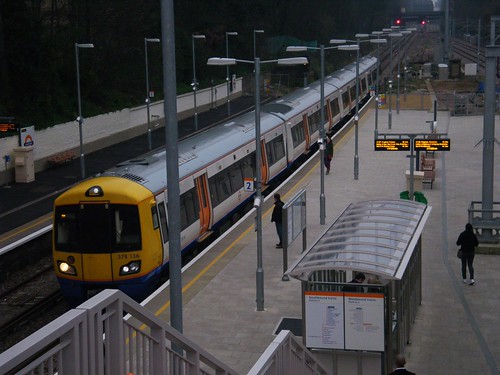
Following the row over the award of the Thameslink rolling stock contract to Siemens, the Secretary of State for Transport has put the decision about rolling stock for Crossrail on hold.
This project needs a thorough rethink, especially at the western end of the route. It should not run over the GW main line beyond Heathrow Junction. One possible option would be to run the trains onto the Hammersmith branch of the Metropolitan, thereby releasing capacity on the busiest stretch of the Circle Line.
The whole service could then form part of the London Overground system. That answers the fleet procurement question, as a further build of the Bombardier class 378 would do the job nicely.
torsdag 25 augusti 2011
Gaddafi escapes
fredag 19 augusti 2011
What does it matter so long as you love the Lord?

"What does it matter so long as you love the Lord?"
A friend of mine says this when I say that I need to go to the Catholic church on Sunday. The other options are to sit in the woods and pray, or go to the local Protestant church, (above), a little architectural gem.
This is the view that all religions are as good as each other so it does not really matter what religion one follows. As a Catholic my friend ought to know better.
Jesus Christ is the Lord. Jesus founded the church and ordered its sacraments.
And I say to thee: That thou art Peter; and upon this rock I will build my church, and the gates of hell shall not prevail against it.
It is as simple as that. Of course we should love the Lord. And if we love him we will do as he says, and that includes keeping the rules of the church: going to Mass every Sunday and on Holy Days of Obligation, receiving Communion at least once a year, confessing one's sins at least once a year between Lent and Trinity Sunday, and not receiving Communion whilst in a state of sin. It matters.
If you love me by Thomas Tallis
tisdag 16 augusti 2011
Why Orthodoxy?
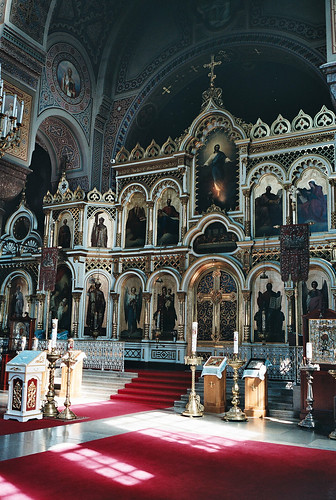
Christians in Western Europe and the US sometimes become members of an Orthodox church - that is, a church not under the jurisdiction of the Pope, the Bishop of Rome. Often, they have previously been Catholics or members of a Protestant church. It is not a decision they will have made lightly and there are many reasons for their choice. They may not like the modern liturgy of the Catholic church, and might feel that the more conservative and antique Orthodox liturgy is more authentic; they may find some of the rules too harsh; they may disapprove of the amount of power that the Pope has; or their motivation may be a combination of all of the above.
Having decided to do this, the first question that arises is which Orthodox church to join. The Russian? Not if one has no connection whatsoever with Russia. The Greek? On the face of things, Greece is less specifically national, but in practice it is a church mostly for immigrants from Greek-speaking countries, in Britain, from Cyprus. So it is an ethnic minority church. All that are left after that are are the national churches of the smaller Balkan countries, plus Finland and Estonia.
A friend of mine opted for the Orthodox church, and faced with the need to make a decision, somehow ended up in the Euphorbian Orthodox Church, the national church of Euphorbia, a small country that was formerly behind the Iron Curtain. Their church is a converted Baptist chapel off the Portobello Road - very nicely done with some good ikons. It which takes him the best part of an hour to get to from where he lives in Stoke Newington. Services are in Euphorbian, an obscure language unrelated to any other in the world. I am not quite sure why he picked on the Euphorbian church rather than the Greek or the Russian one, but I get the impression that he found the congregations at the others were a bit stand-offish, whereas the Euphorbians were open and friendly.
The Orthodox churches are not Protestant, share the same creed with the Catholics and their priests have valid Apostolic orders. I have attended Orthodox services in Eastern Europe and have always been impressed by the beauty and prayerful quality of the liturgy. In contrast, Catholic services these days tend to be on the rough-and-ready side. But almost wherever one goes, the churches are pretty much filled with the usual mixture of people of local origin, immigrants and vistors from abroad. The liturgy is just about acceptable, though it would be better if protestant hymns were weeded-out and the priests were properly disciplined to "Say the black - do the red". My preference is for the kind of liturgy one finds at the London Oratory - which others might regard as a bit of conceit these days.
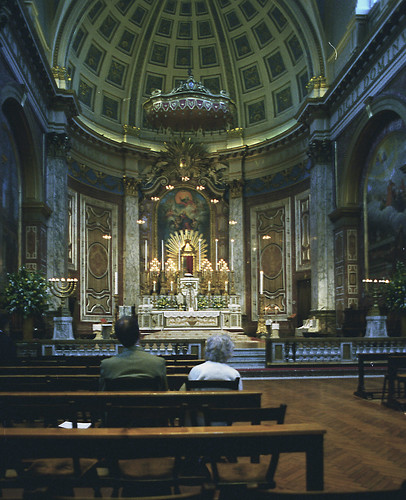
There is much to be admired in Orthodoxy. The liturgy has not been tampered with, unlike that of the Catholic church, in recent years to its great detriment. It has a particular spirituality uninfluenced by Protestantism.
But the Orthodox Churches are national churches and have inevitably fallen under the control of emperors, kings, presidents, and dictators. A further difficulty arises in those countries which are outside the geographical areas that come under the Orthodox jurisdictions of Constantinople, Moscow, etc., which means that there are problems in countries that fall within the geographical jurisdiction of Rome. In those countries, the Orthodox churches will always be expatriate churches composed of immigrants - or else, what might be termed minority interest groups; the situation in the USA is chaotic, with long-established Russian Orthodox communities in Alaska, founded when the state was part of Russia, plus others formed of different immigrant groups. Membership of such congregations means being cut off from both the wider and the local Christian community, with all the consequences that follow from that separation. Instead of travelling half way across London every Sunday, my friend could attend his local Catholic church five minutes' walk from where he lives and become a part of that community.
The ultimate problem, however, is that the Petrine ministry was established by Jesus Christ himself (Matthew 16:18) for good reasons - to provide a person to whom all Christians can look as the source of authority, thereby ensuring that the true doctrine is maintained, unchanged and undiluted, whilst at the same time acting as a source for the interpretation of doctrine in the context of a changing world. Without the Petrine office, the church must in the end become a living fossil.
Postscript - April 2017
Pope Benedict resigned two years after I wrote this piece. We are four years into his successor's papacy. The "reform of the reform" which was gathering pace in 2011, four years after Summorum Pontificum, was arrested and further progress has been stalled. The picture looks less clear than it did then.
Ruthless Capitalism
I came across a piece recently discussing a problem whose causes were attributed to "ruthless Capitalism". What other kind is there? But then, what is Capitalism anyway? Capital is the fisherman's boat and tackle, the workman's tools. That is not ruthless.
The term Capitalism is bandied around freely, but what precisely is Capitalism as a system of economic organisation? Almost nobody has ever taken the trouble to dissect it and expose its constituent parts. Marx used the term sloppily, promoting confusion and contributing to 100 million deaths in the last century.
To judge from its fruits, it cannot reasonably be claimed that Capitalism is untainted. If the concept is dissected, its intrinsically evil components are readily discernable. Any notion of "caring Capitalism" is an oxymoron.
The primary evil of Capitalism is the private appropriation of the goods provided by nature, in particular, the surface of the earth, and following on from that as a consequence, the charging of interst for money loans. Both are, incidentally, contrary to the teaching of scripture.
There no more moral justification for claiming ownership of the surface of the planet than there is for claiming ownership of air. According to that principle, and if the technology made it possible, it would be acceptable to remove all the oxygen from the air and sell it back to people at the going market price. Nor is there any moral justification or economic necessity for the charging of interest. It should neither be expected or charged.
If the components that are systematically evil were to be stripped out, would not be Capitalism but something else.
The main excuse in support of Capitalism is that the only alternative is socialism which has always failed. This is a mark of lazy thinking. There are other models altogether.
måndag 15 augusti 2011
The Assumption
Signum magnum
apparuit in caelo:
mulier amicta sole,
et luna sub pedibus ejus,
et in capite ejus
corona stellarum duodecim.
lördag 13 augusti 2011
Gangster chic no longer so chic
There is a nice symmetry about this report that I came across in the Guardian.
"The riots affected a broad range of businesses, from Debenhams to Boots, Carphone Warehouse and Argos, which said 18 stores had been looted. A report this week said at least 10% of retail and leisure businesses had been either directly or indirectly hit by the riots.
"But JD Sports became the enduring image of the devastation. Robin Knight, a retail expert at restructuring firm Zolfo Cooper, said it was targeted because it is seen to 'embody youth culture'.
" 'the riots are a wake-up call for the fashion brands that JD Sports stocks. They have cultivated a 'gangster chic' image and found themselves targeted by looters across the country. A PR and branding expert said that image was now coming back to haunt them. 'The riots are an absolute disaster for a number of brands. From the day the Daily Mail and the Guardian used that picture of the hoodie equipped completely in Adidas it has become a massive crisis.
"Many brands have spent millions developing 'gangster chic' and 'dangerwear' images. A rioter dressed head-to-toe in Adidas was pictured on the front pages of most of the country's national newspapers on Tuesday. One of the youngest offenders appeared at court this week in a full Adidas tracksuit. The brand, which is one of the major sponsors of the 2012 Olympics, took the step of condemning its customers for taking part in the riots. 'Adidas condemns any antisocial or illegal activity,' the company said. 'Our brand has a proud sporting heritage and such behaviour goes against everything we stand for.'
"Another industry commentator said that brands have been aligning themselves with gang and criminal culture for decades but ramped up their association with less clean-cut figures in recent years."
I wonder whether this will mean the end of that stupid style of having nearly all of one's underpants in full view?
Article here
"The riots affected a broad range of businesses, from Debenhams to Boots, Carphone Warehouse and Argos, which said 18 stores had been looted. A report this week said at least 10% of retail and leisure businesses had been either directly or indirectly hit by the riots.
"But JD Sports became the enduring image of the devastation. Robin Knight, a retail expert at restructuring firm Zolfo Cooper, said it was targeted because it is seen to 'embody youth culture'.
" 'the riots are a wake-up call for the fashion brands that JD Sports stocks. They have cultivated a 'gangster chic' image and found themselves targeted by looters across the country. A PR and branding expert said that image was now coming back to haunt them. 'The riots are an absolute disaster for a number of brands. From the day the Daily Mail and the Guardian used that picture of the hoodie equipped completely in Adidas it has become a massive crisis.
"Many brands have spent millions developing 'gangster chic' and 'dangerwear' images. A rioter dressed head-to-toe in Adidas was pictured on the front pages of most of the country's national newspapers on Tuesday. One of the youngest offenders appeared at court this week in a full Adidas tracksuit. The brand, which is one of the major sponsors of the 2012 Olympics, took the step of condemning its customers for taking part in the riots. 'Adidas condemns any antisocial or illegal activity,' the company said. 'Our brand has a proud sporting heritage and such behaviour goes against everything we stand for.'
"Another industry commentator said that brands have been aligning themselves with gang and criminal culture for decades but ramped up their association with less clean-cut figures in recent years."
I wonder whether this will mean the end of that stupid style of having nearly all of one's underpants in full view?
Article here
torsdag 11 augusti 2011
Catholic bookshop targeted in looting frenzy
An unreported victim of the London riots is the Catholic bookshop in front of Westminster Cathedral, but I got this report from an eyewitness...
The bookshop was besieged by a large gang of teenagers and men and women in their early twenties, who smashed the windows with bricks. They then burst into the shop and helped themselves to rosaries, statues of Our Lady, and The Holy Infant of Prague. After that, they walked over to the Cathedral, knelt down on the steps and recited all five decades of the Glorious Mysteries. Others cleared the shelves of CTS pamphlets, waving them triumphantly in the air before sitting down outside in the square and starting to read them with rapt attention.
The older members of the gang went for more valuable items, taking as many CDs of Gregorian Chant as they could stuff down their T-shirts. A few, who obviously knew exactly what they were after, grabbed every copy of the £90 Liber Usualis they could find on the shelves before making their way into the stock room where they discovered more. Other looters made a beeline for the 1962 Missal and again, every single copy was taken from the shelves and stock room.
Another target was translations of the works of St Thomas Aquinas, St Teresa of Avila and St Augustine, as well as the present Pope. Books by authors such as Karen Armstrong and Karl Rahner, and music from the publishers Kevin Mayhew, however, were left undisturbed.
Despite the proximity of New Scotland Yard, calls to the police were ignored.
The manageress of the shop said that she was both shocked and puzzled, though she had noticed there had been a bit of a run on Liber Usualis and the 1962 Missal recently.
"We only started stocking them a few months ago when people had come in and asked. I was dubious at first but they have been flying off the shelves. I still can't understand why. This latest business is a mystery. I wouldn't have thought anyone would even have been interested in any of that old stuff.
"But there's no accounting for tastes, is there? If they won't even take the CDs of music by Babette Squirrel and Peter Pinewood when they can have them for nothing, I am just going to have to put them in the 5p box - they must be worth it for the empty cases. We just have to keep up with the demand."
onsdag 10 augusti 2011
What do the riots prove?
The riots in UK cities will be endlessly discussed and dissected over the coming months. Copycat-wise, like an epidemic, they seem to be running their course across the country. They will die out, either of their own accord or when cold, wet weather sets in. The parliamentary debate will be mostly a event of posturing, mudlinging and mutual blame, in which the participants, having regards to the circumstances, behaving little better than rioters themselves. That is part of the trouble. When those at the top behave badly and help themselves to whatever goodies they can grab hold of, they can hardly complain when the underclass follows suit.
An aquaintance of mine in the Metropolitan Police told me several years ago that things were coming to the boil. There seem to be several essential ingredients needed to get something like this going. These includeThat is a complex brew. A generation has gone feral. The first of the rioters appear to have been mostly of Afro-Caribbean origin, but it is only a matter of time before white youths in the same age group join in. This has been evident for the past decade. It is not even a particularly British phenomenon. It has happened in France, and last summer there was rioting in Swedish cities.
- A poor urban environment
- Bad schooling
- Alienated youth
- Poor economic opportunities
- Broken or disintersted family circumstances
- Poor political leadership
- Bad diet
- The benefits/welfare "culture"
The declining influence of religion is part of the picture. The black youths who were involved in the first of the troubles would be descendants of immigrants who came in the 1950s to satisfy the shortage of labour for low-paid service jobs, which have largely gone. The culture in the Caribbean immigrants' countries of origin was strongly and strictly Christian Pentecostal, and the immigrants brought it with them. Whilst this remains, things are evidently not what they were or we should not be seeing this kind of behaviour on this scale amongst that group of immigrants. Interestingly, shopkeeping Muslim immigrants from Turkey have organised self-defence groups against the violence.
måndag 8 augusti 2011
Otøya - a double evil
The evil of the Norwegian bombing and shootings lies not just in the events themselves, but in their consequence, which will be to stifle public debate.
There are real decisions about the future of Europe that need to be openly discussed. From the end of the Roman period until the Reformation - a period of around 1100 years, Western Europe was Catholic-Christian. For the past 450 years it has been split between Catholic and Protestant Christian. That transition was not a smooth one - the period from 1550 to 1650 was marked by almost continuous war and insurrection. Post-Reformation, the character of those countries that had gone over to Protestantism was very different. Indeed, there were differences according to which strand of Protestantism had become dominant.
Christianity has been on the decline in Western Europe for the past 50 years. If Islam became the religion most practised in Western Europe, that would transform the societies in those countries where it happened.
Are we comfortable with this possibility?
There are real decisions about the future of Europe that need to be openly discussed. From the end of the Roman period until the Reformation - a period of around 1100 years, Western Europe was Catholic-Christian. For the past 450 years it has been split between Catholic and Protestant Christian. That transition was not a smooth one - the period from 1550 to 1650 was marked by almost continuous war and insurrection. Post-Reformation, the character of those countries that had gone over to Protestantism was very different. Indeed, there were differences according to which strand of Protestantism had become dominant.
Christianity has been on the decline in Western Europe for the past 50 years. If Islam became the religion most practised in Western Europe, that would transform the societies in those countries where it happened.
Are we comfortable with this possibility?
lördag 6 augusti 2011
Is Islamophobia racist?
It is unfortunate that most Muslims in Europe have coloured skins because objectors to Islam are immediately branded as racists. Some Islamophobes might be. The majority possibly are. This makes liberals willing to defend what they would immediately condemn as intolerable and fascistic if Muslims were predominantly blond and blue-eyed.
Islam presents particular difficulties. Uniquely amongst world religions, was founded by a violent war lord with psychopathic tendencies. In the absence of any authority to decide one way or another, whether his revelations were of divine origin or the effects of mental illness must remain an unanswered question. And the grounding text of Islam, whatever its origins are, contains passages that amount to hate literature.
An Islamic society is not one that people brought up in contemporary liberal Western European societies would feel comfortable to live in. The widespread fear is that Islam will end up filling the gap left by Christianity. Whereas in the past Islam was spread by military conquest, demographics could now achieve the same affect. An additional factor is that the societies where this happened in the early years of Islamic expansion had much in common with the contemporary west. In his book The Great Heresies, Hilaire Belloc wrote a (longish) chapter on Islam under the title "The Great and Enduring Heresy of Muhammed" (see previous post). This is essential reading if the nature of Islam and the reasons for its success are to be understood. There is good cause to be afraid.
And so Islamophobia is not necessarily racist. If Muslims wish to be accepted in Europe, they need to look at their own beliefs in a critical way and be prepared to change when they do not like what they see. This needs to be pointed out in the nicest possible way, but firmly nevertheless. It does not give anyone an excuse for being racist.
Islam presents particular difficulties. Uniquely amongst world religions, was founded by a violent war lord with psychopathic tendencies. In the absence of any authority to decide one way or another, whether his revelations were of divine origin or the effects of mental illness must remain an unanswered question. And the grounding text of Islam, whatever its origins are, contains passages that amount to hate literature.
An Islamic society is not one that people brought up in contemporary liberal Western European societies would feel comfortable to live in. The widespread fear is that Islam will end up filling the gap left by Christianity. Whereas in the past Islam was spread by military conquest, demographics could now achieve the same affect. An additional factor is that the societies where this happened in the early years of Islamic expansion had much in common with the contemporary west. In his book The Great Heresies, Hilaire Belloc wrote a (longish) chapter on Islam under the title "The Great and Enduring Heresy of Muhammed" (see previous post). This is essential reading if the nature of Islam and the reasons for its success are to be understood. There is good cause to be afraid.
And so Islamophobia is not necessarily racist. If Muslims wish to be accepted in Europe, they need to look at their own beliefs in a critical way and be prepared to change when they do not like what they see. This needs to be pointed out in the nicest possible way, but firmly nevertheless. It does not give anyone an excuse for being racist.
fredag 5 augusti 2011
Siemens ugly duckling

How has the Siemens train for Thameslink come to end up looking like this? Of more concern for the passengers is that it looks like a rehash of the wretched class 319 units that have plagued the route since it opened in the late 1980s, with windows and doors in precisely the same positions, and complete with unglazed sliding door pockets.
This practically guarantees either that loading and unloading will be slow or that there will be insufficient, and/or cramped seating - and on a route where passengers may be on the train for an hour or more.
And what is the reason for the sharp curvature of the bodyside at floor level? This cannot be necessary in order to clear the loading gauge, because there are projecting steps at each doorway. The main effect of this curvature is to reduce further the limited width available at floor level, an inconvenience that will probably be compounded by fitting ducts at skirting level.
This train appears to perpetuate the general trend in British rolling stock design - that each generation of trains is worse than the one before.
The Great and Enduring Heresy of Mohammed
The influx of Muslims into Western Europe has at least had the benefit that it has led to an increase in public knowledge of Islam. The conclusion of Ramadan, for instance, this week, produced a crop of articles on the subject. Moslems in northern Europe have a hard time, with sunrise in Stockholm, for instance, at 4.40 am and sunset at 9 pm - a lack of universality that is evidence, I would suggest, that Islam is not of divine origin.
Hilaire Belloc regarded Islam as a heresy of Christianity and devoted an entire chapter to it in his book The Great Heresies. Belloc also drew attention to the similarities between Islam and the residual Calvinism that is an important strand in religion in the USA. The following is an extract.
If anyone sets down those points that orthodox Catholicism has in common with Mohammedanism, and those points only, one might imagine if one went no further that there should have been no cause of quarrel. Mohammed would almost seem in this aspect to be a sort of missionary, preaching and spreading by the energy of his character the chief and fundamental doctrines of the Catholic Church among those who had hitherto been degraded pagans of the Desert. He gave to Our Lord the highest reverence, and to Our Lady also, for that matter. On the day of judgment (another Catholic idea which he taught) it was Our Lord, according to Mohammed, who would be the judge of mankind, not he, Mohammed. The Mother of Christ, Our Lady, "the Lady Miriam" was ever for him the first of womankind. His followers even got from the early fathers some vague hint of her Immaculate Conception.
But the central point where this new heresy struck home with a mortal blow against Catholic tradition was a full denial of the Incarnation.
Mohammed did not merely take the first steps toward that denial, as the Arians and their followers had done; he advanced a clear affirmation, full and complete, against the whole doctrine of an incarnate God. He taught that Our Lord was the greatest of all the prophets, but still only a prophet: a man like other men. He eliminated the Trinity altogether.
With that denial of the Incarnation went the whole sacramental structure. He refused to know anything of the Eucharist, with its Real Presence; he stopped the sacrifice of the Mass, and therefore the institution of a special priesthood. In other words, he, like so many other lesser heresiarchs, founded his heresy on simplification.
Catholic doctrine was true (he seemed to say), but it had become encumbered with false accretions; it had become complicated by needless man-made additions, including the idea that its founder was Divine, and the growth of a parasitical caste of priests who battened on a late, imagined, system of Sacraments which they alone could administer. All those corrupt accretions must be swept away.
There is thus a very great deal in common between the enthusiasm with which Mohammed's teaching attacked the priesthood, the Mass and the sacraments, and the enthusiasm with which Calvinism, the central motive force of the Reformation, did the same. As we all know, the new teaching relaxed the marriage laws - but in practice this did not affect the mass of his followers who still remained monogamous. It made divorce as easy as possible, for the sacramental idea of marriage disappeared. It insisted upon the equality of men, and it necessarily had that further factor in which it resembled Calvinism - the sense of predestination, the sense of fate; of what the followers of John Knox were always calling "the immutable decrees of God."
Mohammed's teaching never developed among the mass of his followers, or in his own mind, a detailed theology. He was content to accept all that appealed to him in the Catholic scheme and to reject all that seemed to him, and to so many others of his time, too complicated or mysterious to be true. Simplicity was the note of the whole affair; and since all heresies draw their strength from some true doctrine, Mohammedanism drew its strength from the true Catholic doctrines which it retained: the equality of all men before God "All true believers are brothers." It zealously preached and throve on the paramount claims of justice, social and economic.
Now, why did this new, simple, energetic heresy have its sudden overwhelming success?
One answer is that it won battles.
onsdag 3 augusti 2011
The logic of permanent war
The little intervention in Libya to get rid of a dictator who is mad, bad and ludicrous has now turned into a small war. Why is anyone surprised at this?
Bombs, once manufactured, have to be used, otherwise stockpiles build up and they have to be expensively stored. Since the companies who produce the things are not going to shut down their factories and let their valuable investment go for scrap, constant war is a logical policy.
War also has the advantage of keeping other news from public attention and directs comment away from the incompetence of politicians. Governments in countries which do not have the option of running wars on a perpetual basis must keep their constituents satisfied by doing their job reasonably well.
Bombs, once manufactured, have to be used, otherwise stockpiles build up and they have to be expensively stored. Since the companies who produce the things are not going to shut down their factories and let their valuable investment go for scrap, constant war is a logical policy.
War also has the advantage of keeping other news from public attention and directs comment away from the incompetence of politicians. Governments in countries which do not have the option of running wars on a perpetual basis must keep their constituents satisfied by doing their job reasonably well.
tisdag 2 augusti 2011
Stop the scrounging parasites
The real parasites in Britain are not those claiming a few quid in benefits to feed their families but those who feed off the profits earned by their workforce. (FT article)
måndag 1 augusti 2011
The future of British democracy

South Georgia Island_DSC4344, a photo by jc_on_vacation on Flickr.
It is my firm belief that elective democracy has had its day in Britain. It can not work in a country where the biggest-selling newpapers are things like News of the World.
The country would be better off if it was run by people selected at random from a list. We judge suspected criminals that way so it is not such a dreadful thing. Even if we ended up with 90% of the members of parliament being unable to string a sentence together, that would still leave around sixty competent and reasonably honest people in charge, with no vested interests to protect and no expectation of a place on the boardroom afterwards.
In the meantime one can fantasise. Mine would be to send all politicians to a rather uncomfortable place of permanent exile when they leave office. South Georgia comes to mind. The only exceptions would be those who could show that they had never willingly sought office.
söndag 31 juli 2011
Opposition bandwagon rolling nicely
The opposition to HS2 is now gathering momentum, as articles such is this, one of no less than six on the subject, published the Daily and Sunday Telegraph in the past few days.
Part of the case is made by those speaking up in support for local transport. But argument for HS2 on the grounds that we need increased capacity is not still not being countered effectively.
The argument is simple. The cost of building, equipping and operating a high speed railway is proportional to at least the square of the running speeds. That is a consequence of the laws of physics, as applied in an engineering context.
At a conservative estimate the cost of a 200 mph railway be double that of a 100 mph one. Advocates of HS2 would have us believe that as we need extra capacity which can only be provided by building a new railway (true), it might as well be a high speed one as it will only cost a teeny-weeny bit more (false).
The optimum speed for inter-city trains in Britain is between 100 mph and 130 mph. Faster than that leads to diminishing returns.
Part of the case is made by those speaking up in support for local transport. But argument for HS2 on the grounds that we need increased capacity is not still not being countered effectively.
The argument is simple. The cost of building, equipping and operating a high speed railway is proportional to at least the square of the running speeds. That is a consequence of the laws of physics, as applied in an engineering context.
At a conservative estimate the cost of a 200 mph railway be double that of a 100 mph one. Advocates of HS2 would have us believe that as we need extra capacity which can only be provided by building a new railway (true), it might as well be a high speed one as it will only cost a teeny-weeny bit more (false).
The optimum speed for inter-city trains in Britain is between 100 mph and 130 mph. Faster than that leads to diminishing returns.
fredag 29 juli 2011
Personal space
An experiment by KLM, though it is not clear why it only applies to business passengers.
torsdag 28 juli 2011
High speed rail is not dangerous
Whatever conclusions can be drawn from the high speed rail accident in China, doubts over safety are not one of them. The Japanese and French safety records are outstandingly good. A German ICE trains were involved in a single incident in 1998 which was due to the use of a type of wheel technology developed for use in tramways. However, that accident would not have happened had the conductor applied the emergency brake when a passenger reported what was obviously a serious problem.
What the Chinese accident does demonstrate, however, is that corners cannot be cut and that everyone involved needs to know exactly what they are doing.
High speed rail cannot be done on the cheap,
What the Chinese accident does demonstrate, however, is that corners cannot be cut and that everyone involved needs to know exactly what they are doing.
High speed rail cannot be done on the cheap,
tisdag 26 juli 2011
Fundamentalists and fanatics
In 2007, the Royal Palace in Oslo did not even have railings around it. It would be nice if last Friday's tragedy did not change this, but it is unlikely.
Although the attack turns out to have been by a lunatic with allegiance to the extreme right, with an overtone of Christian fundamentalism, it is telling that the first assumptions were that it was the work of Islamic terrorism.
That is not course not to say that events like that in Oslo require any ideology at all to motivate them - personal grudges and hatreds are often sufficient. However, the perpetrators of these kinds of atrocities often turn out to have fed on a diet of hate literature. It comes in many forms. The extreme right has its own canon of this material, founded on a paranoid fear of difference. The far left looks to Marx and his insistence on the necessity of class warfare. Islam looks to the Koran, which, if not hate literature, contains passages which are potential incitements to hatred. The same can be said about the bible, but that is moderated by the mainstream churches, which can assert authoritatively, how potentially problematic passages are to be interpreted. The real difficulty with religious texts occurs in the absence of recognised authority. This is why Christian fundamentalism and Islam in general can lead people into trouble.
Usually, of course, it does not. But when mentally disturbed individuals get it into their heads to do something, whether on their own or in conjunction with other people, then nasty things are liable to happen.
Although the attack turns out to have been by a lunatic with allegiance to the extreme right, with an overtone of Christian fundamentalism, it is telling that the first assumptions were that it was the work of Islamic terrorism.
That is not course not to say that events like that in Oslo require any ideology at all to motivate them - personal grudges and hatreds are often sufficient. However, the perpetrators of these kinds of atrocities often turn out to have fed on a diet of hate literature. It comes in many forms. The extreme right has its own canon of this material, founded on a paranoid fear of difference. The far left looks to Marx and his insistence on the necessity of class warfare. Islam looks to the Koran, which, if not hate literature, contains passages which are potential incitements to hatred. The same can be said about the bible, but that is moderated by the mainstream churches, which can assert authoritatively, how potentially problematic passages are to be interpreted. The real difficulty with religious texts occurs in the absence of recognised authority. This is why Christian fundamentalism and Islam in general can lead people into trouble.
Usually, of course, it does not. But when mentally disturbed individuals get it into their heads to do something, whether on their own or in conjunction with other people, then nasty things are liable to happen.
Prenumerera på:
Inlägg (Atom)
Ultimate net zero lunacy?
The ultimate net zero lunacy is probably de-carbonising and trying to electrify the entire railway system. In the first place, the railways...
-
I wrote to my MP on two entirely separate issues recently. The first was to do with the replacement for the Inter City 125 train, which at £...
-
The ultimate net zero lunacy is probably de-carbonising and trying to electrify the entire railway system. In the first place, the railways...
-
The FT has run a couple of pieces on Sweden this week. The first was a report of the outbreak of car burning, the second, today, on the rise...


